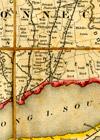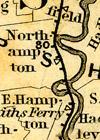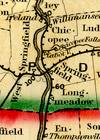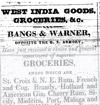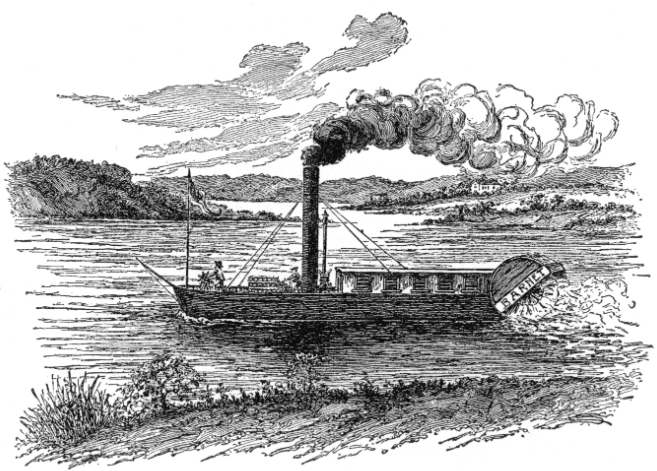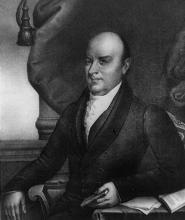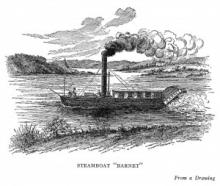
Built between 1824 and 1826 by Brown and Bell shipbuilders of New York, the steamboat Barnet was seventy-five feet long and displaced only twenty-two inches of water. This extremely shallow draft allowed the vessel to navigate the rapids at Enfield Falls.
At Warehouse Point the combination of unfavorable wind and insufficient power prevented Barnet from completing the trip up the falls in Enfield.
Companies
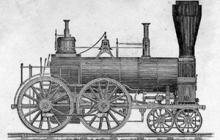
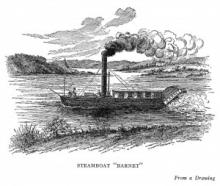
Hartford business leaders founded the company in response to commercial rivals in New Haven, and in 1824 the company commissioned Brown and Bell, a New York shipbuilder, to build a steamboat that could navigate the rapids between Hartford and Springfield. The steamboat Barnet made its successful maiden voyage to Springfield in 1826, thereby assuring the continued commercial viability of Springfield and Hartford.
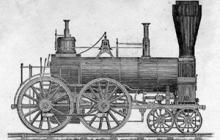
People
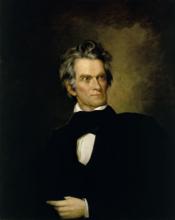
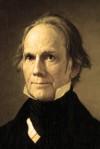
Henry Clay was an American politician from Kentucky, who served in the Kentucky State Legislative, the U.S. House of Representatives and the U.S. Senate. Clay was an advocate of the “American System”. In addition to his support for the American System, Clay was well known as a skilled politician, orator and one of the men behind the Missouri Compromise of 1820 and the Compromise of 1850.
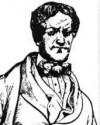
John Fitch was an American inventor and entrepreneur most famous for operating the first commercial steamboat in the United States. On August 22, 1787, with delegates from the Constitutional Convention meeting in Philadelphia observing, Fitch’s steamboat navigated the waters of the Delaware River. Fitch operated the vessel, which had a capacity of thirty passengers, between Philadelphia and Burlington, New Jersey and hoped to make the venture profitable, but shortcomings with both his patent (1791) and his business skills led investors to pull out of his company and the business failed.
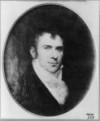
Robert Fulton was an American inventor and engineer of the first commercially successful U.S. steamboat, the Clermont (1807). The Clermont was based on the ideas of John Fitch. In 1807, Fulton successfully tested his vessel on the Hudson River; thereafter he won the right to operate steamboats on Hudson and on other rivers in New York State, as well as on the lower Mississippi.

- The Lathrop Letters between Samual and his son document the Barnet’s first voyage
Samuel Lathrop was an important political leader in the early 1800s, both at the state and federal level. He served in the Massachusetts Senate before serving four successive terms in Congress. He then returned to his home state to serve in the State Senate for another two years, serving in 1829 and 1830 as President of the State Senate. Samuel Lathrop was serving in Congress at the time of the Barnet’s maiden voyage.

William Lathrop was born in Springfield to a prominent Connecticut River Valley family. His grandfather, the Rev. Joseph Lathrop, served as minister of the First Congregational Church of West Springfield for sixty-three years and dedicated the first bridge to span the Connecticut River. His father, Samuel Lathrop, was an important political figure. William Lathrop’s correspondence to his father, who was serving in Congress at the time, provides a record of the steamboat Barnet’s maiden voyage in 1826.
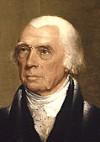
The fourth president of the United States, Monroe proposed the American System to develop the national economy. His successor, James Madison, took steps to launch the program.
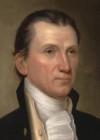
The fifth president of the United States, Monroe backed the American System, which included the investment of federal dollars in the construction of new roads and canals and the improvement of harbors.
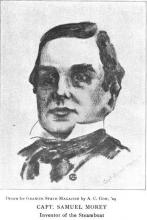
An Orford, New Hampshire inventor and engineer, Morey launched the first steamboat on The Connecticut River. From 1780 to 1830, Morey experimented with steam to propel boats, taking out various patents for steam machinery. In his lifetime, he registered over 20 patents relating to combustion engines and steamboat transportation. In 1792, he and a friend used the vessel to travel up the Connecticut River from Orford, New Hampshire to Fairlee, Vermont at four miles per hour, and returned.

A widely known river boatman from West Springfield, Captain Palmer was in command of Barnet when the steamboat embarked on her maiden voyage in 1826.
Places
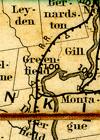
An area along the banks of the Connecticut River Greenfield was called cheapside by locals.

The Connecticut River is the largest river in New England, flowing 407 miles from its source near the Canadian border in the Connecticut Lakes to its mouth at Long Island Sound. The river forms most of the border between New Hampshire and Vermont, and flows through western Massachusetts and central Connecticut.
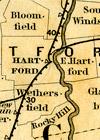
Established in 1635 on the banks of the Connecticut River in Connecticut, by the first quarter of the nineteenth century, Hartford had become an important commercial center linked to Springfield, Massachusetts and through New York City, to the markets of the world. Hartford benefited from the development of canals and improvements in river transport such as steamboats.
